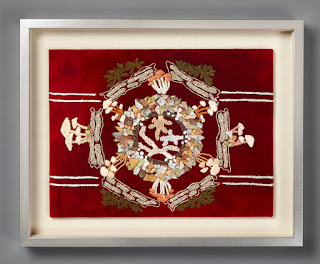Woodland Fungi of Swallow Cliff Woods, IL
Boundary Layer
The top few inches of the
earth’s crust is home to some of the most fascinating and necessary micro
habitats on the planet. Before early land plants first escaped the oceans, the
way would have been prepared by crustose lichens whose enzymes have the ability
to break down the hard, rocky surfaces. Lichens attract and retain moisture and
dust particles that in turn create the perfect conditions for micro plants like
mosses and liverworts to survive desiccating winds and manage water resources. Mosses also provide a home for the
water-loving hyphae of fungi and a microscopic zoo of creatures. These small
organisms form the necessary foundation for a succession of larger vascular
plants to thrive.
Medieval Reliquaries from the
Art Institute of Chicago inspired the creation of this work. These bejeweled
receptacles housed the venerated bones of saints and provided an apt metaphor
for valuing and celebrating this community of diminutive plants and organisms.
Many thanks to the scientists
and organizations that helped me learn about these micro habitats and the
organisms that inhabit them.
Office of the Provost, Columbia College
Chicago for a faculty grant
Dr. Patrick
Leacock, School of The Art Institute, Illinois Mycological Association
Paul Mayer, Field
Museum
Wyatt
Gaswick, Field Museum
Lorinda Sues, Illinois Mycological Association
LichensMaritimes.org for their
permission to use photographs for reference
Dr. Erin A. Tripp, University of
Colorado, author of “Field Guide to the Lichens of White Rocks Open Space”
Dr. Matt Nelsen, Field Museum
Dr. Matt Von Konrat, Field Museum
Michael Kuo, author of “Mushrooms
of the Midwest”
Burns Bog at the Delta Nature
Reserve, Vancouver, B.C. Canada


